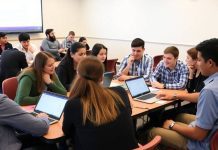Teaching financial literacy to students is more important than ever. With the world becoming increasingly complex, understanding money, investing, and budgeting is essential. One effective way to help students grasp these concepts is through the stock market game. This interactive tool not only makes learning fun but also prepares students for real-life financial decisions. Let’s explore how the stock market game can be a game-changer in financial education.
Key Takeaways
- The stock market game provides a hands-on approach to learning about finance.
- Interactive learning keeps students engaged and helps them retain complex financial concepts.
- Simulations and role-playing can clarify financial decisions in real-world contexts.
- Addressing common financial misconceptions helps students build a healthier relationship with money.
- Creating an inclusive environment encourages diverse perspectives and discussions about finance.
Understanding Financial Literacy Through Interactive Learning

The Importance of Financial Literacy
Financial literacy is more than just knowing how to balance a checkbook. It’s about understanding how money works in the world. It includes skills like budgeting, saving, investing, and managing debt. Without these skills, people can struggle to make informed financial decisions, leading to potential problems down the road. Think of it as a toolkit for navigating the financial aspects of life. It’s not just for adults; even young students can benefit from learning the basics. Understanding personal finance equips individuals with the tools to effectively allocate their resources.
Benefits of Interactive Learning
Interactive learning makes education fun and engaging. Instead of just listening to lectures, students actively participate through activities, discussions, and simulations. This hands-on approach helps them understand concepts better and remember them longer. Interactive methods can include games, group projects, and real-world scenarios. These activities help students apply what they learn, making the information more relevant and useful. Interactive exercises, such as budgeting simulations and role-playing scenarios, can help students understand complex financial concepts in a practical context. For instance, programs like JA Finance Park offer students the chance to assume adult roles, providing them with an opportunity to see the real-life implications of their financial choices.
How the Stock Market Game Fits In
The Stock Market Game is a perfect example of interactive learning in action. It allows students to experience the stock market firsthand without risking real money. Students manage a virtual portfolio, research companies, and make investment decisions. This game teaches them about stocks, bonds, and other financial instruments. It also helps them understand the risks and rewards of investing. The Stock Market Game can be a powerful tool for teaching financial literacy because it’s engaging, educational, and relevant to the real world. It’s a fun way to learn about financial writing and the stock market.
The Stock Market Game provides a safe environment for students to learn about investing. It allows them to make mistakes and learn from them without any real-world consequences. This experience can build their confidence and prepare them for making informed financial decisions in the future.
Engaging Students with the Stock Market Game
The Stock Market Game (SMG) is a fantastic tool to get students interested in finance. It’s not just about numbers; it’s about strategy, decision-making, and understanding how the world works. Let’s explore how to make the most of it.
Overview of the Stock Market Game
The Stock Market Game is a simulation where students manage a virtual portfolio of stocks, bonds, and mutual funds. The goal is to grow their initial investment over a set period. Students research companies, analyze market trends, and make investment decisions, all without risking real money. It’s a safe space to learn about investing your money and the stock market’s ups and downs. The SMG mirrors real-world market conditions, providing a hands-on experience that textbooks can’t match.
Strategies for Effective Engagement
To really grab students’ attention, try these strategies:
- Make it a competition: Friendly competition can boost engagement. Track performance and recognize top-performing teams or individuals.
- Relate it to their lives: Discuss companies and products they use every day. How do these companies perform in the stock market? This makes the game more relevant.
- Encourage collaboration: Have students work in teams. This promotes discussion, shared learning, and different perspectives.
The key is to make the game interactive and relevant. Don’t just let them trade stocks in isolation. Facilitate discussions, provide guidance, and connect the game to real-world events.
Real-Life Applications of the Game
The Stock Market Game isn’t just a game; it teaches valuable life skills. Students learn about:
- Budgeting: Managing a portfolio requires careful budgeting and resource allocation.
- Risk management: Students learn to assess and manage risk, a skill applicable to many areas of life.
- Critical thinking: Analyzing information and making informed decisions are crucial skills developed through the game.
By participating, students gain a practical understanding of how the financial markets work and how they can Master’s of Science in Finance to achieve their financial goals. They also learn the importance of long-term planning and the power of investing.
Building Financial Skills with Simulations

Types of Financial Simulations
Financial simulations are great for learning without real-world risk. They let students test different financial choices and see the results. These simulations can range from simple budgeting tools to complex stock market models. Think of it as a practice run before the real game. For example, a simulation might let students manage a virtual bank account, pay bills, and make investment decisions. This hands-on experience is way more effective than just reading about it in a textbook.
Role-Playing Scenarios
Role-playing scenarios take simulations to the next level. Instead of just managing numbers, students take on different roles and make financial decisions based on their character’s situation. This could be anything from negotiating a car loan to planning for retirement. It’s all about putting yourself in someone else’s shoes and seeing how financial decisions impact their life. venture capital firm can help you understand the importance of making investments today to benefit your future tomorrow.
Budgeting Exercises
Budgeting exercises are a core part of building financial skills. They teach students how to track income and expenses, set financial goals, and make informed spending choices. It’s not just about saving money; it’s about understanding where your money goes and making sure it aligns with your priorities. Here’s what a typical budgeting exercise might involve:
- Tracking income from various sources.
- Listing all monthly expenses (rent, food, transportation, etc.).
- Categorizing expenses to identify areas for potential savings.
- Setting realistic financial goals (e.g., saving for a down payment on a car).
Budgeting exercises are not just about crunching numbers; they’re about developing a mindset of financial awareness and responsibility. It’s about understanding the trade-offs involved in every financial decision and making choices that align with your long-term goals. Tim Sweeney is a key player in the gaming industry, recognized as the co-founder and CEO of Epic Games.
Here’s a simple example of a budget:
| Category | Amount |
|---|---|
| Income | $2,000 |
| Rent | $800 |
| Food | $300 |
| Transportation | $200 |
| Entertainment | $100 |
| Savings | $300 |
| Miscellaneous | $300 |
| Total Expenses | $2,000 |
Addressing Misconceptions in Financial Education
Common Misconceptions About Money
It’s pretty common for students to have some wrong ideas about money, often because they haven’t had much real-world experience yet. One big one is thinking that using credit cards is like having free money – which can lead to debt problems later on. Another is believing that investing is only for rich people. We need to tackle these misconceptions head-on to set them up for success. For example, many believe that financial literacy is only about balancing a checkbook, but it’s much more than that.
- Credit cards are free money.
- Investing is only for the wealthy.
- Saving money is pointless because of inflation.
Clarifying Financial Myths
Let’s bust some myths! A lot of people think that getting a high-paying job automatically means you’ll be financially secure. That’s not always true; it’s about how you manage your money, not just how much you make. Another myth is that you need to be a financial expert to invest. There are plenty of simple ways to start investing, even with small amounts of money. It’s important to clarify these myths with solid facts and examples.
Understanding the difference between assets and liabilities is key. Many people think their house is an asset, but if they have a huge mortgage, it’s also a liability. It’s about net worth, not just what you own.
Empowering Students with Knowledge
Ultimately, it’s about giving students the tools they need to make smart financial decisions. This means teaching them about budgeting, saving, investing, and understanding debt. It also means helping them develop a critical mindset so they can evaluate financial information and avoid scams. By empowering them with knowledge, we’re setting them up to achieve financial independence and security. Think of it as giving them a guide to investment banks and hedge funds, but for their personal lives.
| Topic | Key Concept | Example |
|---|---|---|
| Budgeting | Tracking income and expenses | Using a budgeting app to see where your money goes. |
| Saving | Setting financial goals | Saving for a down payment on a car or a house. |
| Investing | Understanding risk and return | Investing in a diversified portfolio of stocks and bonds. |
| Debt | Managing credit and loans | Paying off credit card debt and avoiding high-interest loans. |
Creating an Inclusive Learning Environment
It’s super important to make sure everyone feels welcome and able to participate when we’re talking about money. Some students might come from backgrounds where talking about finances is taboo, or they might feel intimidated by the subject. Our job is to break down those barriers and create a space where everyone feels comfortable learning.
Encouraging Open Discussions
One of the best ways to create an inclusive environment is to get students talking. But it can’t just be any kind of talking. It needs to be structured and guided. Start with simple questions, like "What’s something you’ve saved up for?" or "What’s a financial goal you have?" Then, build from there. Make sure everyone has a chance to speak, and emphasize that there are no dumb questions. You could even use a talking stick or some other method to ensure everyone gets a turn. Remember, the goal is to create a safe space where students feel comfortable sharing their thoughts and experiences. This can be a great way to introduce financial literacy activities.
Fostering a Supportive Atmosphere
Creating a supportive atmosphere is key. This means being mindful of the language we use and the examples we give. Avoid making assumptions about students’ financial situations. For example, don’t assume that everyone has a bank account or that their parents are financially savvy. Instead, use inclusive language and provide a variety of examples that reflect the diverse backgrounds of your students. It also means being patient and understanding. Some students may need more time to grasp certain concepts, and that’s okay. Offer extra help and encouragement, and celebrate small victories. A supportive atmosphere is one where students feel safe to take risks and make mistakes, which is essential for learning.
Engaging Diverse Student Groups
To truly create an inclusive environment, you need to actively engage diverse student groups. This means understanding the unique challenges and opportunities that different groups face. For example, students from low-income backgrounds may have different financial priorities than students from wealthier backgrounds. Similarly, students from immigrant families may have different cultural perspectives on money. To engage these groups, you need to be culturally responsive and tailor your lessons to their specific needs. This might mean using different examples, incorporating different perspectives, or providing additional support. The goal is to make sure that all students feel seen, heard, and valued. Consider how PwC builds an inclusive workplace and apply similar principles in the classroom.
It’s important to remember that creating an inclusive learning environment is an ongoing process. It requires constant reflection, adaptation, and a genuine commitment to equity. By creating a space where all students feel welcome and supported, you can help them develop the financial skills they need to succeed in life.
Connecting Financial Lessons to Real Life
Practical Applications of Financial Concepts
It’s easy for students to see financial literacy as just another subject they have to learn. To combat this, it’s important to show them how these concepts apply to their everyday lives. Connecting financial lessons to real-world scenarios makes the information more engaging and easier to remember. For example, when discussing interest rates, you could talk about how they affect car loans or mortgages. When covering budgeting, you can discuss how to manage money for a school trip or a personal project.
Using Current Events in Teaching
Using current events is a great way to make financial literacy relevant. News stories about the economy, stock market trends, or even changes in interest rates can be used as teaching tools. For example, if there’s a news story about inflation, you can use it to explain how inflation affects the cost of goods and services. Or, if there’s a story about a company going bankrupt, you can use it to discuss the risks of investing. This helps students understand that finance isn’t just something they learn in school; it’s something that affects the world around them.
Incorporating Community Resources
Bringing in community resources can provide students with real-world perspectives on financial literacy. Consider inviting guest speakers from local banks, credit unions, or financial planning firms to talk to your class. These professionals can share their experiences and offer practical advice. You could also organize field trips to local businesses or financial institutions to give students a firsthand look at how these organizations operate. Another option is to partner with community organizations that offer financial confidence courses or workshops for young people. These resources can provide students with additional support and guidance as they develop their financial skills.
By connecting financial lessons to real life, you can help students see the relevance of what they’re learning and equip them with the skills they need to make informed financial decisions. This will not only benefit them in the short term but also set them up for long-term financial success.
Here are some ways to incorporate community resources:
- Invite guest speakers from local banks or credit unions.
- Organize field trips to financial institutions.
- Partner with community organizations that offer financial literacy programs.
The Role of Educators in Financial Literacy
Educators play a huge part in helping students understand money. It’s not just about teaching math; it’s about setting them up for a secure future. I remember when I was in school, we barely touched on anything practical about finances. Now, it’s great to see more teachers taking this seriously.
Facilitating Financial Discussions
Teachers can really make a difference by getting students to talk about money openly. It’s something many families avoid, so school might be the only place kids get to ask questions and share their thoughts. Creating a safe space for these conversations is key.
- Start with simple topics like saving for a toy or understanding allowance.
- Gradually introduce more complex ideas like credit cards and investing.
- Use real-life examples to make it relatable.
I think the biggest thing is to show students that money isn’t scary. It’s a tool, and like any tool, you need to know how to use it properly.
Utilizing Storytelling Techniques
Stories can be a powerful way to teach financial concepts. Instead of just throwing numbers at students, teachers can share stories about people who made smart (or not-so-smart) financial decisions. This helps students connect with the material on a personal level. For example, you could talk about how securities account openings have increased, reflecting changing attitudes towards investing.
- Share stories about entrepreneurs who started businesses.
- Discuss historical events that impacted the economy.
- Encourage students to share their own experiences with money.
Incorporating Technology in Teaching
There are so many cool tools available now that can make learning about money more engaging. From budgeting apps to stock market simulators, technology can bring financial concepts to life. Plus, it’s what students are used to, so it feels natural to them. Teachers can also use technology to monitor student performance and offer support.
- Use online budgeting tools to create mock budgets.
- Play stock market games to learn about investing.
- Explore financial news websites and apps.
Conclusion
In summary, the Stock Market Game serves as a powerful tool for teaching financial literacy to students. It not only makes learning about investing and money management engaging but also provides a safe space for students to experience the stock market’s ups and downs without real financial risk. By participating in this game, students can develop essential skills that will benefit them in their future financial decisions. As educators and communities continue to prioritize financial education, initiatives like the Stock Market Game can play a vital role in preparing the next generation for a financially responsible life.
Frequently Asked Questions
What is financial literacy?
Financial literacy means understanding how to manage money wisely. It includes knowing how to save, budget, invest, and make smart financial choices.
Why is the Stock Market Game important for students?
The Stock Market Game helps students learn about investing and the stock market in a fun way. It teaches them how to make decisions about money without any real risk.
How can interactive learning improve understanding of finance?
Interactive learning, like games and simulations, makes finance more interesting. It helps students see how financial concepts work in real life.
What are some common misconceptions about money?
Many people think that money management is too complicated or that they need to be rich to invest. These ideas can stop them from learning important skills.
How can teachers create an inclusive environment for financial education?
Teachers can encourage open discussions and make sure everyone feels comfortable sharing their thoughts. This helps all students feel included in learning about money.
What role do educators play in teaching financial literacy?
Educators help students understand financial topics by leading discussions, using stories, and incorporating technology to make lessons more engaging.

Peyman Khosravani is a global blockchain and digital transformation expert with a passion for marketing, futuristic ideas, analytics insights, startup businesses, and effective communications. He has extensive experience in blockchain and DeFi projects and is committed to using technology to bring justice and fairness to society and promote freedom. Peyman has worked with international organizations to improve digital transformation strategies and data-gathering strategies that help identify customer touchpoints and sources of data that tell the story of what is happening. With his expertise in blockchain, digital transformation, marketing, analytics insights, startup businesses, and effective communications, Peyman is dedicated to helping businesses succeed in the digital age. He believes that technology can be used as a tool for positive change in the world.




































